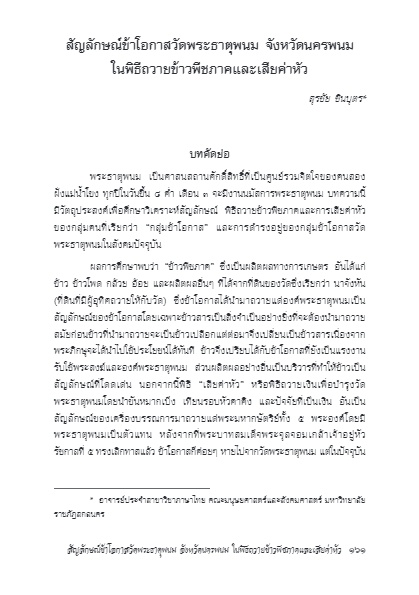สุรชัย ชินบุตร
บทคัดย่อ
พระธาตุพนม เป็นศาสนสถานศักดิ์สิทธิ์ที่เป็นศูนย์รวมจิตใจของคนสองฝั่งแม่น้ำโขง ทุกปีในวันขึ้น 8 คํ่า เดือน 3 จะมีงานนมัสการพระธาตุพนม บทความนี้มีวัตถุประสงค์เพื่อศึกษาวิเคราะห์สัญลักษณ์ พิธีถวายข้าวพีชภาคและการเสียค่าหัวของกลุ่มคนที่เรียกว่า “กลุ่มข้าโอกาส” และการดำรงอยู่ของกลุ่มข้าโอกาสวัดพระธาตุพนมในสังคมปัจจุบัน
ผลการศึกษาพบว่า “ข้าวพีชภาค” ซึ่งเป็นผลิตผลทางการเกษตร อันได้แก่ ข้าว ข้าวโพด กล้วย อ้อย และผลิตผลอื่นๆ ที่ได้จากที่ดินของวัดซึ่งเรียกว่า นาจังหัน (ที่ดินที่มีผู้อุทิศถวายให้กับวัด) ซึ่งข้าโอกาสได้นำมาถวายแด่องค์พระธาตุพนมเป็นสัญลักษณ์ของข้าโอกาสโดยเฉพาะข้าวสารเป็นสิ่งจำเป็นอย่างยิ่งที่จะต้องนำมาถวาย สมัยก่อนข้าวที่นำมาถวายจะเป็นข้าวเปลือกแต่ต่อมาจึงเปลี่ยนเป็นข้าวสารเนื่องจากพระภิกษุจะได้นำไปใช้ประโยชน์ได้ทันที ข้าวจึงเปรียบได้กับข้าโอกาสที่ยังเป็นแรงงานรับใช้พระสงฆ์และองค์พระธาตุพนม ส่วนผลิตผลอย่างอื่นเป็นบริวารที่ทำให้ข้าวเป็นสัญลักษณ์ที่โดดเด่น นอกจากนี้พิธี “เสียค่าหัว” หรือพิธีถวายเงินเพื่อบำรุงวัดพระธาตุพนมโดยนำขันหมากเบ็ง เทียนรอบหัวคาคิง และปัจจัยที่เป็นเงิน อันเป็นสัญลักษณ์ของเครื่องบรรณการมาถวายแด่พระมหากษัตริย์ทั้ง 5 พระองค์โดยมีพระธาตุพนมเป็นตัวแทน หลังจากที่พระบาทสมเด็จพระจุลจอมเกล้าเจ้าอยู่หัว รัชกาลที่ 5 ทรงเลิกทาสแล้ว ข้าโอกาสก็ค่อยๆ หายไปจากวัดพระธาตุพนม แต่ในปัจจุบันนี้ท่ามกลางความเปลี่ยนแปลงของสังคม ยังมีกลุ่มคนที่เรียกตนเองว่า ข้าโอกาสได้นำข้าวพีชภาคและการเสียค่าหัวมาถวายแด่องค์พระธาตุพนมทุกปี ซึ่งแสดงให้เห็นถึงการดำรงอยู่ของข้าโอกาสในยุคปัจจุบัน การศึกษาเรื่องนี้สะท้อนให้เห็นถึงความเชื่อและศรัทธาของคนอีสานและชาวลาวประเทศ สปป.ลาว ต่อองค์พระธาตุพนมอันเป็นสิ่งศักดิ์สิทธิ์คู่บ้านเมืองที่ยึดเหนี่ยวจิตใจของคนทั้งสองฝั่งแม่น้ำโขงตลอดมา
(ตีพิมพ์ใน วารสารไทยศึกษา ปีที่ 9 ฉบับที่ 2 (สิงหาคม 2556 – มกราคม 2557) หน้า 161-189)
Symbols of the Monastery Serfs of Wat Phra That Phanom in Khao Phichaphagaya Offering and Sia Kha Hua Ritual
Surachai Chinabutr
Abstract
Phra That Phanom, originally located on Doi Kapanakiri or Phu Kam Pra, is a spiritual center of the Mekong riverine people, located in That Phanom District of Nakorn Phanom Province. Annually, on the full moon of the third lunar month, the ritual of paying homage to Phra That Phanom is held. This paper aims to analyze the symbolization of the rites of the Khao Phichaphagaya offering and the Sia Kha Hua ritual to the Kha-okasa group (monastery serfs) of Wat Phra That Phanom and their existence in modern society.
It has been discovered that Khao Phichaphagaya refers to agricultural crops including rice, corn, bananas, and sugar cane, harvested from the monastery land, called a windmill field, donated to the monastery. On the 8th day of the 3rd lunar month, the monastery serfs offer Khan Mak Beng, and golden and silver flowers, symbolizing the contributions, of the five kings who constructed Phra That Phanom. In addition, they perform the Sia Kha Hua ritual (donations for maintaining the monastery). Terminated by the Proclamation of Slave Independence by King Rama V, the monastery serfs of Wat Phra That Phanom gradually disappeared from the monastery. However, even arnidst rapid social change, these inherited rites at Wat Phra That Phanom are annually performed. This study reflects the monastery serfs’ beliefs in Phra That Phanom in modern society.
(Published in Journal of Thai Studies Volume 9 Number 2 (August 2013 – January 2014) Page 161-189)
บทความ / Full Text : Download
